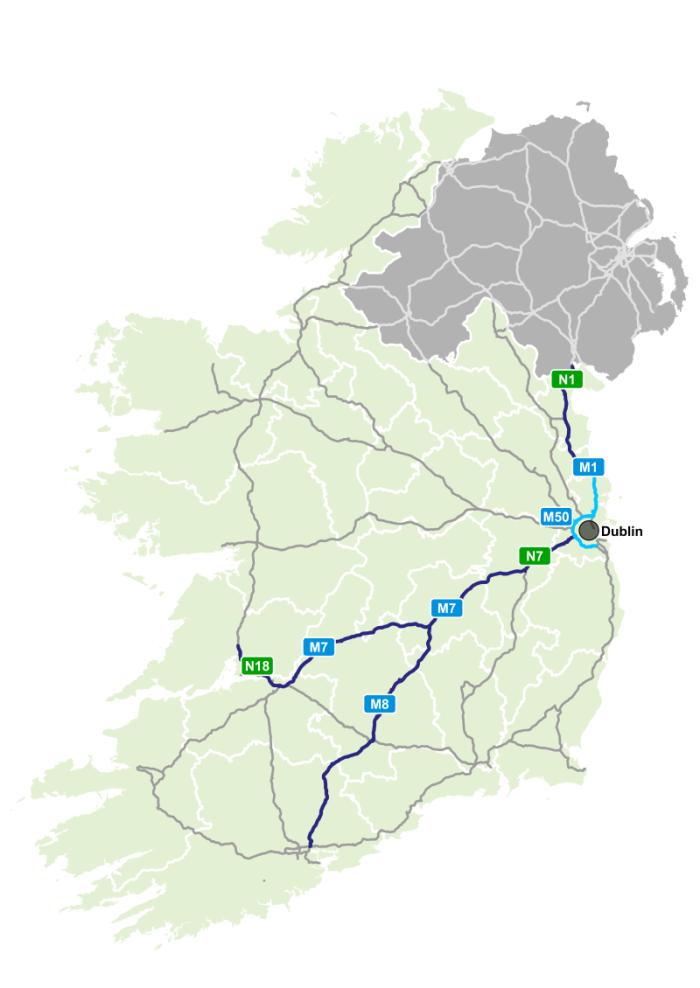Ireland's National Cooperative ITS (C-ITS) Pilot
Transport Infrastructure Ireland (TII) is piloting Cooperative Intelligent Transport Systems (C-ITS) services to enhance road safety, traffic efficiency, and environmental benefits. The pilot covers the TEN-T comprehensive roads network and evaluates vehicle-to-vehicle (V2V) and vehicle-to-infrastructure (V2I) services, such as Hazard Location Notifications, Road Works Warnings, and In-Vehicle Signage. It employs a hybrid communication approach using WiFi (ITS-G5) and standard cellular networks. The project is co-financed by the EU Connecting Europe Facility (CEF) with a budget of €10.2M.
What is C-ITS?
C-ITS improves road safety, traffic efficiency, and driver comfort by enabling road users and operators to share information and coordinate actions through digital connectivity. It enabled with simple event notifications, such as traffic jams, hazardous locations, and weather conditions, to be transmitted directly to drivers in a way that allows users to be informed but not distracted.
C-Roads Platform
The C-Roads Platform is a joint initiative of European Member States and road operators to harmonise C-ITS pilot installations, ensuring interoperability across Europe. This interoperability will ensure that Irish vehicles will receive CITS messages when in Europe and C-ITS equipped European vehicles will receive messages in Ireland. This includes developing technical specifications and conducting cross-site testing.
Click here to view the Core members of this platform
| C-Roads Ireland - ID of Grant Agreement |
|---|
|
Grant Agreement under Connecting Europe Facility (CEF) – Transport Sector Agreement number: INEA/CEF/TRAN/M2018/1784778
Action No: 2018-IE-TM-0080-S
Action name: C-Roads Ireland
Budget: €10,161,141.5
Maximum CEF contribution: €5,080,570.5
Duration: 01/01/2019 – 31/12/2023
Agency: Innovation and Networks Executive Agency (INEA)
Beneficiary: Department of Transport (former DTTaS)
Implementing Body: TII – Transport Infrastructure Ireland
|
C-ITS Ireland Pilot
The pilot involves designing, procuring, installing, testing, running, and evaluating C-ITS services on the TEN-T network and parts of Dublin's road network. Objectives include understanding C-ITS deployment and evaluating its impact on technical performance, socio-economic benefits, and user acceptance.
In February 2024, the EU CEF co-funded C-ITS Pilot Project was launched to the public, with over 900 participants receiving messages via in-vehicle equipment or a mobile app. These messages, sent by operators at TII’s Motorway Operations Control Centre, included incident alerts, journey times, and safety messages. The pilot concluded in December 2024, with an evaluation report highlighting positive changes in driving behaviour and benefits to safety, efficiency, and society
C-ITS Pilot Operations
The Irish C-ITS pilot involves the installation of an On-Board Unit (OBU) in volunteers’ vehicles. The OBU will then display pre-defined signs, along with short text messages, on a tablet screen to inform drivers of the state of the road ahead with the aim of improving safety on the road network.
A dedicated smartphone app has also been developed for drivers that cannot have an OBU installed in their vehicle, which can display the same pre-defined signs and text messages on a smartphone screen.
C-ITS Pilot Services
The Irish C-ITS Pilot will provide pilot participants, along relevant pilot corridors, with real time notifications using a combination of signs and free-text.
The piloted services include:
- In Vehicle Signage including Regulatory speed limit information, Advisory speed limit information and advanced notice of Lane Merge Left
- Hazardous Location Notification including Traffic Jam Ahead and Stationary Vehicle as well as weather specific warnings for Snow, Hail, Rain and High Winds
- Road Work Warning for Mobile Road Works, Lane closure and Road closure
- Dublin Tunnel Closure (NB/SB), delays at Dublin Port and Dublin City HGV Cordon status
C-ITS Pilot Location
The pilot will cover 355 KM of the Irish Motorway network including the M50 around Dublin, the N7/M7 to Limerick in the West, the M8 to Cork in the South, and the M1 to the border North of Dundalk.
- M7, N7, M8, N1 – C-ITS services supported via cellular communications (dark blue on map)
- M50 and M1 – C-ITS services supported by a combination of cellular and ITSG5 Road Side Units (RSU), providing direct digital communication between roadside infrastructure and vehicles (I2V) (light blue on map)
What are Road Side Units (RSUs)
RSUs are road-side devices that transmit messages on the road network status to and from C-ITS equipped vehicles via short range radio signals, in a similar way to home wi-fi routers, but they are specifically designed to communicate with devices moving at high (motorway) speeds.

Additional Links



Disclaimer: The content of this article does not reflect the official opinion of the European Union. Responsibility for the information and views expressed in the article therein lies entirely with the authors.

